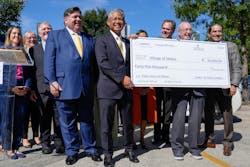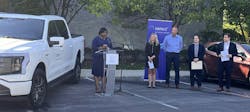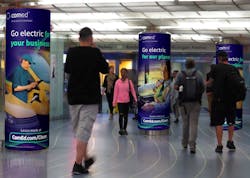Equitable EV Programs Gain Momentum
Key Highlights
- Illinois saw a three to fourfold increase in EV registrations in early 2025, surpassing national growth rates.
- ComEd’s programs have funded over 5,500 charging ports and supported 1,400 fleet vehicles, with 78% of rebate funds directed to low-income communities.
- Rebate initiatives include up to $180,000 for fleet EVs, site make-ready incentives, and residential chargers, making EVs more affordable and accessible.
- Stakeholder networks and community partnerships facilitate education, infrastructure deployment, and trust-building in underserved neighborhoods.
Electric vehicle adoption is accelerating across Illinois — fast. In the first quarter of 2025, new electric vehicle (EV) registrations in the state grew three to four times faster than in the U.S. as a whole, relative to the same period in 2024. One likely reason, the state’s largest utility, Commonwealth Edison Co. (ComEd), launched new EV programs as part of its first beneficial electrification plan.
Since their launch, these programs have incentivized over 5,500 new public and private EV charging ports (roughly one port energized every two hours over the last 17 months) and supported the purchase or lease of over 1400 new and preowned electric fleet vehicles to date.
Most notable is where the support is going: 78% of the rebate funds paid by ComEd have gone to low-income customers and those located in or primarily serving low-income and equity-eligible communities. At the center of this unprecedented equitable transition is a deliberate, equity-focused strategy that prioritizes access, affordability and trust, along with close collaboration with a wide range of stakeholders including the state and multiple other partners in the private and public sector.
This transition is only at the beginning, as ComEd recently received approval to continue investing in customer EV programs through 2028.
The Illinois Transition
Illinois has come a long way in the transition to EVs. According to the Illinois Office of the Secretary of State, the state has over 142,000 full battery electric EVs registered today, a sharp increase from the barely two dozen EVs registered in 2010. The state has a goal of 1 million EVs by 2030, set by Gov. J.B. Pritzker in 2021.
Significant barriers exist for widespread and equitable adoption of EVs in Illinois and across the country. The three most often encountered are high upfront costs, limited access to charging infrastructure and limited education on EVs. Signed in September 2021, Illinois’ Climate and Equitable Jobs Act (CEJA) amended the Electric Vehicle Act (EVA) to include beneficial electrification provisions designed to remove barriers, tap into the state’s electric grid, and deliver greater climate and air quality benefits.
Beneficial electrification (BE) is the replacement of direct fossil fuel use (for example, gasoline, diesel, propane and heating oil) with electricity. By definition, BE must result in net quantifiable benefits to society through reduced emissions, cost savings and improved electric grid operations, as an example. BE includes transportation electrification measures — that is, transitioning from internal combustion engine vehicles to EVs. EVs rely on electricity rather than on gasoline or diesel fuel, which makes them a low- or zero-emissions transportation option that does not release pollutants such as carbon dioxide, sulfur dioxide, nitrogen oxides and particulate matter through a tailpipe at surface level.
First BE Plan
ComEd’s first BE plan (BE Plan 1) was approved by the Illinois Commerce Commission in 2023. It is an investment of up to US$231 million total between 2023-2025 in customer rebates, as well as education, awareness and pilot programs, to support the state’s EV adoption goals while delivering net benefits to all of ComEd’s 4 million customers.
ComEd’s BE Plan 1 has equity front and center, reserving more than half of its rebate funds for — and offering higher incentives to — low-income (LI) customers and those located in equity investment eligible communities (EIECs) throughout ComEd’s service territory. The utility’s plan focuses on incentives for electric fleet vehicles of all weight classes and on public and private charging infrastructure, both of which are instrumental to delivering on the plan’s benefits and supporting Illinois’ EV goals.
Rebate Programs
ComEd’s BE Plan includes three new EV rebate programs to support the purchase and installation of residential EV charging, the purchase or leasing of electric fleet vehicles and reduce the financial burden for nonresidential customers to make a site ready for EV charging. ComEd launched these new programs in February 2024, announcing Walker Miller Energy Services as its implementation partner and making nearly $200 million available across all three rebate programs between 2024 and 2025:
- The first and largest of ComEd’s rebate programs offers rebates of up to $180,000 for the purchase or lease of new and preowned fleet EVs of all weight classes, including transit and school buses. Fleets as small as one vehicle are eligible for the program and both business and public sector customers can participate.
- The second rebate program offers business and public sector customers rebates to make a site ready for level 2 (L2) or direct-current fast-charging (DCFC) EV charging infrastructure deployment. This make-ready program covers up to $8000 per L2 port and up to $1000 per kW of DCFC for public or private installations. Eligible costs include customer-incurred electrical costs, civil costs, contracting and permitting.
- ComEd’s third rebate program offers residential customers up to $3750 in rebates for the purchase and installation of smart L2 EV chargers at home. Participating customers also get to switch to a time-variant supply rate from ComEd or an alternative retail electric supplier, allowing them to save by charging their EVs during times when rates are the lowest, thereby increasing grid utilization.
Provider Networks
ComEd has cultivated two critical provider networks to streamline access to EVs and EV charging and boost participation. Both networks were launched in 2024:
- A network of fleet EV dealers and manufacturers integrates ComEd’s rebates at the point of sale, slashing upfront costs for EIEC businesses and public entities. For example, a small delivery company in Waukegan was able to switch to EVs without paying anything upfront because the dealer used a voucher to cover the cost.
- A growing network of Illinois Commerce Commission-certified EV service providers (EVSPs) support the design and installation of EV charging infrastructure for residential and nonresidential customers, with many of the members offering instant rebates on behalf of their customers.
As of July 2025, over 170 participants were enrolled in ComEd’s dealer network, including dealers, auto groups and direct-sale original equipment manufacturers. ComEd’s EVSP network has also grown to over 120 members, of which more than 20% are diverse-business certified (for example, minority, women or veteran owned), a figure ComEd is actively increasing through targeted recruitment in EIEC regions. These stakeholder networks not only drive participation but also foster economic opportunity, as local contractors join the electrification workforce.
Resources and Partnerships
In addition to its new rebate programs and provider networks, ComEd also launched multiple customer EV resources in 2023 and 2024, including a fleet EV tool kit (adding to its existing residential EV tool kit), an interactive EV load capacity map and free fleet electrification assessments (FEAs). These tools help business and public sector customers assess their fleet and charging infrastructure needs from a variety of angles, highlighting cost-saving options in transitioning to an EV, identifying prime locations with ample grid capacity for larger EV charging infrastructure and offering personalized, expert assessments from ComEd staff for customers interested in fleet electrification and charging infrastructure deployment.
ComEd has also partnered with the Metropolitan Mayors’ Caucus, a collaboration of mayors throughout Illinois, on its EV readiness program. The program equips municipal governments in the ComEd region to advance transportation electrification by facilitating investment in EV charging infrastructure, promoting beneficial electrification and expanding EV market opportunities.
The program uses an EV readiness checklist as the organizing framework for municipal resources, best practices and policy templates that support strategic actions for communities to gain “EV Ready Community” designation, such as zoning and planning, permitting, safety and community engagement. To date, the EV readiness program has designated 23 municipalities as EV Ready, with more receiving this designation in 2025. It has also become a model for the national Interstate Renewable Energy Council’s (IREC) charging smart program, focused on increasing EV adoption nationwide.
Equity-Eligible Communities
ComEd’s success in promoting transportation electrification among low-income and equity investment eligible communities is no accident. It is the result of a deliberate, equity-focused strategy that prioritizes access, affordability, and trust. From the outset, ComEd designed its BE programs with these customers in mind, reserving more than 50% of its customer rebate budget exclusively for LI and EIEC participants and offering them higher rebate amounts. This financial commitment has translated into tangible participation.
ComEd’s equity approach goes beyond higher rebates and reserved funds. Recognizing the unique barriers faced by these communities — such as limited access to information, upfront cost concerns and historical distrust of utility initiatives — ComEd has deployed a multipronged strategy to ensure the benefits of electrification are not just accessible but embraced. This begins with a hyperlocal, multicultural outreach and engagement model tailored to the diverse fabric of northern Illinois.
ComEd has also been listening. By partnering with trusted community-based organizations, local businesses and respected residents, the utility has built bridges into neighborhoods often overlooked by traditional EV adoption programs. ComEd outreach teams have collaborated with community-based organizations in Chicago’s South and West Sides — areas with high EIEC concentrations — to host workshops at community centers, churches, park districts and even a hair salon, ensuring the message of electrification resonates in familiar, comfortable spaces.
This equitable and targeted engagement strategy is deeply intentional. It acknowledges the history of these communities, respecting past challenges like redlining or environmental neglect. Cultural sensitivity is a cornerstone of this program. To reach customers effectively, outreach team members speak Spanish and educational material is available in a variety of languages to reach the widespread population of the area. Events are also chosen to reflect the region’s diversity — from the high-profile Chicago Auto Show to grassroots gatherings like the Bud Billiken Parade, a historic celebration of African American culture in Chicago. Targeted digital campaigns further amplify this effort, with paid social media ads on platforms like Instagram and Nextdoor, programmatic ads geotargeted to EIEC neighborhoods and personalized email blasts that speak directly to residents’ needs — like how an L2 charger can cut charging time compared to standard outlets.
Another initiative that will further boost participation is ComEd’s ambassador program. This program recruits local leaders from diverse organizations — selected for their geographic reach, familiarity with environmental justice or sustainability issues, and ability to connect with underserved populations — to champion electrification. In 2025, 15 team members from three organizations, representing communities from Rockford to the South Side of Chicago, were selected to train on EV benefits and ComEd’s offerings. Each sponsoring organization received a stipend to support their organization, incentivizing participation while empowering local voices. The goal is to have ambassadors directly facilitate rebate applications in their communities, with participants citing the personal connection as a key motivator.
For business and public sector customers, barriers like high upfront costs and long project timelines are tackled head on with innovative program features. The make-ready reservation feature lets EIEC participants reserve funds for charging infrastructure projects that will complete within six months, providing certainty that dollars will be there when the work is done. Since its launch, over 70% of reservations have gone to EIEC businesses, including a community college in Chicago’s Englewood neighborhood planning a charging hub for its shuttle fleet.
Meanwhile, the EV fleet rebate program’s point of sale feature delivers instant rebates via vouchers — reducing a $50,000 EV purchase to $40,000 at signing, for example — making electrification feasible for cash-strapped public entities like rural fire districts and small logistics firms in Rockford.
The numbers speak for themselves. By blending financial incentives, authentic engagement and practical tools, ComEd has not only driven significant participation but also set a blueprint for equitable electrification others could follow.
Outlook
As ComEd marks the first anniversary of its new EV programs, it also celebrates approval from the Illinois Commerce Commission (ICC) to continue investing in beneficial electrification through 2028. The utility’s second BE plan is the result of close collaboration with multiple key stakeholders to ensure alignment of priorities. It is largely a continuation of the programs started in 2024, with some modifications for improvement.
The role of the state and the utility in the equitable transition to EVs has never been more central, and ComEd and the state of Illinois are demonstrating how to make this work and how to continue the momentum going forward.
Editor’s note: To learn more about ComEd’s efforts to support a clean energy future, visit www.ComEd.com/Clean.
About the Author
Cristina Botero
Cristina Botero is the Senior Manager for the Beneficial Electrification (BE) team at ComEd. She serves as ComEd’s primary subject matter expert on Electric Vehicles (EV) and her team is in charge of shaping and evolving ComEd’s Beneficial Electrification plans, strategy, and offerings. She has been with ComEd for five years, and prior to joining ComEd held a variety of Engineering roles with BP, Tesla, Argonne National Lab, the Massachusetts Institute of Technology (MIT), and GE focusing on diverse energy technologies.
Denise Munoz
Denise Munoz is the Director for Strategic Planning & Innovation and Clean Energy Program Implementation at ComEd. Her team designs and manages strategies across the full portfolio of ComEd’s Energy Efficiency and Beneficial Electrification Portfolio and Demand Side Management solutions for customers to support the overall ComEd Strategy, policy and regulatory commitments. Her team also has responsibility for the innovation and new products function ensuring the development of new products and services that directly support the achievement of portfolio targets as a result of the Climate and Equitable Jobs Act (CEJA). Since joining ComEd in 1992, Denise has held a variety of roles in Energy Efficiency, Distribution Operations, Project Management, Regulatory, and Marketing.



